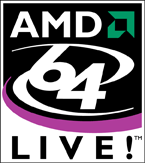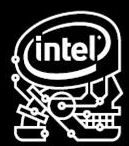Platform Guide: Desktops
GAME

Think of it as Centrino for gamers, but coming from AMD. GAME (sometimes written with a trailing exclamation point, but AMD seems to have dropped that) is meant to be a combination of processor, video card, and motherboard capable of playing contemporary games adequately. Their standard of adequate is an average of 30 frames per second at default settings on a 1280 x 1024 pixel display. "Contemporary" is supposed to mean just that; as time progresses, AMD intends to benchmark new games (whatever is popular at that point in time) and shift the requirements upward. They have indicated that this shift will take place about every 6 months.
One note: AMD's original presentation on the platform indicated that NVIDIA's nForce 500 series of chipsets would also satisfy the program, but the GAME website does not mention that.
Requires: Athlon X2 5600+ Processor, ATI Radeon HD 3650 graphics, AMD 770 chipset, 2 GB or more of DDR2 RAM
GAME Ultra

Like GAME, but more. GAME Ultra is different only in that testing is done at a resolution of 1600 x 1200, and therefore (to meet the 30 FPS target) the system requirements are higher.
Requires: Phenom X4 9650 Processor, ATI Radeon HD 3870 graphics, AMD 770 chipset , 2 GB or more of DDR2 RAM
Live!

The anti-Viiv. Live! is AMD's attempt to get in on the digital home/media platform game. Like the Yamato platform, Live! is very open and could potentially include a very broad sweep of devices. The AMD Live! brand originated in AMD's push to get professional musicians and other media producers to switch to its hardware, principally Opteron processors, and in January 2006 AMD announced it was extending the brand to consumer products. Please note there is a laptop doppelgänger.
Requires: Athlon 64 X2 processor.
Skulltrail

Intel repurposed a workstation motherboard and remarked some Xeons as Core 2 Extremes, all in the name of letting people build a ridiculously powerful, dual-processor gaming system.
Requires: Core 2 Extreme (Socket 771 only), Intel D5400XS motherboard.
Spider

AMD' first stab at a more constrained, "Centrino-style" platform, Spider is targeted squarely at gamers. Spider was launched to accompany the new Phenom series of processors, and was meant to leverage the video cards provided by newly-acquired ATI. Unfortunately, Phenom's performance at launch was underwhelming, and Spider never really took off. It has, for all intents and purposes, morphed into GAME, although there are some traces of it left on AMD's website.
Requires: Phenom processor, Radeon HD 3000-series graphics card, any AMD 7-series motherboard chipset.
Viiv

Viiv (pronounced with a long 'i', like "five" or "vibe") is Intel's "digital living room" package. Viiv is targeted squarely at the "home theater PC" market. Viiv is supposed to pull all of your entertainment needs together in one package. Please note there is a laptop doppelgänger.
Requires: Pentium D or Pentium Extreme Edition, Intel Express chipset (945, 955X, or 975X), Intel High Definition Audio (Azalia), Intel Matrix Storage (RAID 0, 1, 5, 10), Intel Quick Resume (simulated instant on/instant off), and an Intel networking chipset.
Viiv, Core 2 variant

What Intel would very much like everyone to call "Intel® Core™2 Processor with Viiv™ Technology", but most people are quite content to call "Viiv". This is simply the next evolution of the Viiv platform, with new and better processors. The name is odd (there is nothing special about the processors themselves), but in keeping with Intel's newest naming trends. The requirements (which are a touch complicated) are currently listed on Intel's site. Requirements for both this iteration and the older ones are listed on a different page. The processors listed are all 45 nm parts. Please note there is a laptop doppelgänger.
Requires: Core 2 Quad (Q9550, Q9450, Q9300) or Core 2 Duo (E8500, E8400, E8200, E8190) processor, Intel x3x series chipset (X38, P35, G35, G33, G31, P31), Microsoft Windows Vista Home Premium or Ultimate, NCQ-enabled SATA hard drive, Intel High Definition Audio (Azalia), Intel Matrix Storage (RAID 0, 1, 5, 10), and an Intel networking chipset.
vPro

Intended for business desktops, vPro is meant to provide enhanced manageability and security features. Some of which are, in IT parlance, really cool. vPro desktops can be powered up, rebooted, and limitedly controlled remotely from an IT console and have a store of nonvolatile memory to store important data. Intel calls this Active Management Technology.
Requires: Core 2 Duo processor with Active Management Technology, Intel motherboard chipset, Intel networking chipset.
McCreary
McCreary is another iteration of vPro, coming after the 2007 refresh. New in this 2008 version are Remote Alert (system can notify a server when things go awry), Remote Scheduled Management (system can automatically connect to a server and perform basic maintenance like virus scans), Fast Call for Help (essentially Remote Alert, but able to function even if the device is outside the corporate firewall), and IT Director (provides a way to monitor system health).
Requires: 45 nm Core 2 Duo processor, Intel Q45 Express chipset, Intel 82567LM Ethernet controller.
vPro 2007

A refresh of vPro that added one key requirement: support for Trusted Execution Technology (TXT), formerly codenamed LaGrande, and a Trusted Computing Moduele (TPM) to go along with it. vPro 2007also threw something new into the mix: Virtualization Technology for Directed I/O (VT-d), a way of virtualizing input and output (this in addition to the existing Intel VT extensions meant to make virtualization easier on the processor). vPro 2007 is not an official product name (the official name, in line with the new name for Viiv, is Intel® Core™2 Processor with vPro™ Technology), but rather is a creation of the press.
Requires: Core 2 Duo processor with AMT, TXT, and VT-d; Intel Q33 or Q35 motherboard chipset; Intel Gigabit networking chipset.
